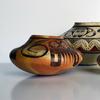Historical Chinese National Military Treasure Surfaces and Hits the Auction Block on June 5th
- ORANGE, California
- /
- May 19, 2016
500x440.jpg)
ORANGE, Calif. -- A historical rarity, the dress sword of Wu Peifu (1874-1939), noted Chinese warlord during the early 20th century and one of the country's beloved figures, will be sold by Cowan’s Auctions, Inc. in conjunction with Little John's Auction Service on June 5 at their Orange, California auction facility. The sword is estimated at $500,000 to $1 million.
A Chinese nationalist hero, General Wu, "The Jade Marshall," is fondly recalled as China's incorruptible, honest warlord. He strove to unify the country and return control to the Chinese people.
The unmarked sword is the work of a master craftsman. In richly gilded bronze, the hilt is cast and chased in high relief with a lion having stone eyes. It is further decorated with two Chinese flags in relief. One is the Five-Stripe flag of the Republic of China, adopted in 1912 and used until 1928, while the other is the Iron Blood 18-Star flag of the Wuchang Uprising, the Wuchang nationalist's flag in use from 1911 until 1928. The hilt ends with a recumbent lion, and the grip is of exotic shell. The nickel scabbard is adorned with two gilt mounts cast and chased with five lions that represent the majesty and rank of a Chinese field marshal of the period.
474x650.jpg)
"It's the best-quality, ornate Chinese sword that could have been in the early 20th century," said John Gangel, founder of Little John's Auction Service.
Wu rose from humble beginnings to become the most powerful warlord in China. During the Warlord Era, 1916 to 1927, national authority dissolved into a patchwork of regions controlled by local leaders. These independent warlord cliques became the most influential entities in China, supported by armies and wielding political power.
Rising as military commander of the Zhili clique in the provenance surrounding Beijing, Wu led his troops to victory through brilliant strategy and unyielding resolve. Even having never held political office, he was heralded for his effort to unify China. By the summer of 1924, the Zhili clique controlled much of the country and had the support of American and English governments.
Wu's fame rose beyond Asia, and in September 1924 he became the first Chinese national to appear on the cover of Time magazine. The photograph shows him gripping the sword now coming to auction.
The Second Zhili–Fengtian War in 1924 brought significant change. In a story that includes betrayals and military reversals, the Japanese-backed Fengtian clique based in Manchuria defeated the Zhili clique.
For the next few years Wu continued to lead his army, but in 1928 he retired in Beijing. In December 1939, shortly after Japan invaded China, the commanding Japanese general demanded Wu emerge from retirement and lead a Chinese puppet state. Wu refused, insisting that all Japanese should leave China. Wu died several days later. The official cause of death was blood poisoning from an infected tooth. However, it is widely believed the Japanese murdered him.
"He basically died for love of country," said Gangel. "The Japanese poisoned him."
500x332.jpg)
Wu's funeral was a national event that received coverage around the world, including three pages in Life magazine, under the headline "Peking Gives Wu Pei-Fu, China's Honest War Lord, A Fine Princely Funeral." Funeral scrolls read, "Riches could not tempt him; power could not subdue him."
The symbol of Wu's success was his ceremonial sword, which he often held when photographed in dress uniform. The unique piece was a mark of his status and rank. The sword has been deemed as China's Excalibur, with Wu as the country's King Arthur.
After Wu retired to Beijing, it is believed his family, which had moved to San Francisco in the 1920s, took the sword to California shortly before the general died. They sold the sword in the late 1930s to the Far West Hobby Shop, the West Coast's largest dealer in antique firearms, historic curios and California relics. John A. Dunker of Palo Alto, a long-time collector of antique weaponry, purchased the sword from the San Francisco shop in 1939. After remaining in his family for several generations, the sword is being offered publicly for the first time.
The sword (lot #240) will be sold on Sunday, June 5, during the first day of a three-day sale. The auction begins at 11 a.m. A public preview will be held on June 4. The auction will take place at Little John's Auction Gallery, 1201 W. Katella Ave., Orange, Calif. Bidding is available in person, by phone, absentee and online through proxibid.com. Little John's is owned by Cowan's Auctions of Cincinnati, Ohio.
For more information, phone John Gangel at (714) 939-1170 or or visit Cowans.com.
Contact:
Evan SikesCowan's Auctions, Inc.
5138711670
cowansmarketing@gmail.com
6270 Este Ave
Cincinnati, Ohio
info@cowans.com
513-871-1670
http://www.cowanauctions.com
About Cowan's Auctions
As one of the nation’s leading auction houses with sales approaching $20 million, Cowan’s has been helping individuals and institutions build important collections for more than a decade. The company’s five divisions of American History, American Indian & Western Art, American and European Fine and Decorative Art, Historic Firearms & Early Militaria, and Modern & Contemporary Ceramics, hold semi-annual cataloged sales that routinely set records for rare offerings. Through its extensive mailing list of more than 40,000 collectors, dealers and institutional clients, each Cowan’s auction typically attracts more than 1,000 bidders from across the globe. To learn more about Cowan’s visit our website at www.cowans.com.

270x400_c.jpg)










_He_Lay_100x100_c.jpg)


_(Medium)100x100_c.jpg)

